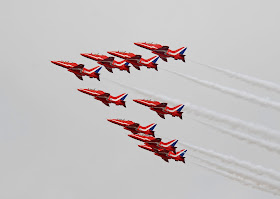





As the weather is so abysmal at the moment, very gloomy with persistent drizzle, I thought I would just brighten up the blog with a few more images from last week's visit to the Lancashire Coast. The images were taken at a high tide roost of bar tailed godwits and knot on a lovely sunny afternoon in perfect light for photography.
Over the weekend the sunny weather deserted us and the Southport Airshow came to town so most of the birds would probably have moved elsewhere for a bit of peace and quiet. I have to admit that I did visit the Airshow and an excellent affair it was,with the highlights being The Red Arrows and the Avro Vulcan Bomber. The Vulcan is the only one of it's type still able to fly and millions of pounds have been spent on it's restoration. The images show bar tailed godwits and knot at the roost and one of three golden plover that briefly paid a visit to the sands. I also had to show a couple of images from the Southport Airshow, the Vulcan Bomber with bomb doors open and The Red Arrows in tight formation. Hopefully my next visit on next week's high tides will once more find the beaches and coast returned to the waders.


























